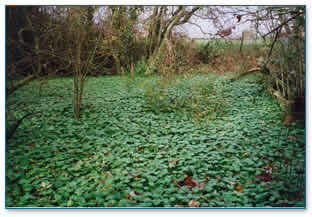creating
wildlife ponds
A pond is basically a hole in
the ground filled with water. Small ponds can be lined with non-porous
material so that they hold water. This material could be concrete,
rubber or thick black plastic. If the pond is dug in clay soil that
is non-porous there is no need for it to be lined. Ponds are often
built with stones and rocks.
 |
A new rock pond |
The simplest way to make a pond
is to buy an ‘instant pond’ made of fibre glass. All
you have to do is to dig a hole the right shape and drop the fibre
glass shell into it. The edge of the pond shell can hidden with
a covering of concrete, paving stones or turf.
Another way of making a pond
is to use a pond liner, a waterproof sheet made of rubber or thick
black plastic. A hole is dug to the required shape and size with
sloping sides - it should be at least 1 to 1.5 metres deep. The
bottom of the pond should be built at different levels so that you
can have a variety of plants. Some water plants like shallow water
and some prefer deep water. The bottom of the hole must be covered
with fine sand or with a layer of old newspaper, so that no sharp
stones can pierce the liner.
|
|
|
designing a wildlife pond or fish
pond
|
Click on the images above to open
an enlarged printer friendly version of these diagrams
After the liner has been laid
over the hole the edges must be held down with paving stones, rockery
stones or turf to keep it in place. When the water is poured in
the liner will mould itself to the shape of the hole.
• Once the pond is finished,
whether it is clay, concrete, fibreglass or plastic lined, the bottom
should be covered with a layer of soil for the plants to grow in.
It is best if you can add some mud taken from another existing pond.
A lot of small animals will be transferred to your pond in the mud.
• Plants can be bought
from a water garden nursery or, with permission of the owner, you
can collect plants from a local pond. The plants should be dug into
the soil at the depth they prefer. Additional animals such as water
beetles and pond snails may be also be found by pond dipping in
an existing pond.
• For a wildlife pond you
should ensure that only native species are planted in the pond.
• Especially avoid invasive
weeds such as Canadian Pond Weed or Water Pennywort because they
will grow quickly and smother other plant life. Some other ones
that can cause problems are:
Parrot’s feather, NZ water stonecrop /Pygmy weed, Water fern
and Nutall’s pondweed, Broad-leaved pondweed, Fennel pondweed,
Bullrush (Reed Mace) and algae in shallow nutrient rich water.
 |
Pond with Yellow
flag Iris |
 |
Floating Pennywort |
Below is a list of plants
and creatures that might inhabit a wildlife pond area:
Adult Damselfly
Adult Dragonfly
Adult Frog
Adult Mayfly
Adult Newt
Algae
Arrowhead
Caddisfly Larva
Cyclops
Damselfly Nymph
Dragonfly Nymph
Duck
Flatwork
Freshwater Shrimp
Tadpoles
Great Diving Beetle
Heron
Kestrel
Kingfisher
Leech
Marsh Marigold
Mayfly Nymph
Midge Larva
Newt Tadpole
Pond Skater
Pond Snail
Reed Mace
Water Boatman
Water Flea
Water Louse
Water Mite
Water Shrew
Water Worm
|

